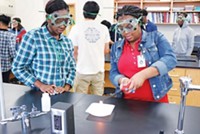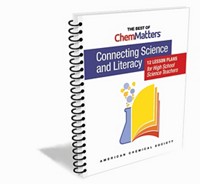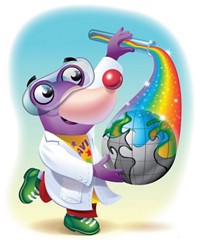Advertisement
Grab your lab coat. Let's get started
Welcome!
Welcome!
Create an account below to get 6 C&EN articles per month, receive newsletters and more - all free.
It seems this is your first time logging in online. Please enter the following information to continue.
As an ACS member you automatically get access to this site. All we need is few more details to create your reading experience.
Not you? Sign in with a different account.
Not you? Sign in with a different account.
ERROR 1
ERROR 1
ERROR 2
ERROR 2
ERROR 2
ERROR 2
ERROR 2
Password and Confirm password must match.
If you have an ACS member number, please enter it here so we can link this account to your membership. (optional)
ERROR 2
ACS values your privacy. By submitting your information, you are gaining access to C&EN and subscribing to our weekly newsletter. We use the information you provide to make your reading experience better, and we will never sell your data to third party members.
Education
Meetings & Learning Through Inquiry
ACS activity book nurtures children's natural curiosity about science
by Linda Wang
June 18, 2007
| A version of this story appeared in
Volume 85, Issue 25

The American Chemical Society Office of K–8 Science has recently released the third edition of its book "Inquiry in Action—Investigating Matter Through Inquiry." Written as a physical science activity guide for upper elementary- and middle-school teachers, the book focuses on inquiry-based learning, which encourages students to think and ask questions rather than memorize information.
"A big part of inquiry is thinking about why you're doing what you're doing and understanding how you came to know what you know," says James Kessler, manager of the Office of K–8 Science and one of the book's authors. "Being able to understand how you came to the knowledge is as important as the knowledge itself."
Joe Exline, founder of Exline Consulting Services and an expert in inquiry-based learning, believes that "we're boring kids to death with some of the things we're doing in science." He explains: "Science is often taught as a history of what we know, and it makes the teacher look good because it might illustrate their vast knowledge, but it's not helping the student." In inquiry-based learning, he says, the responsibility of learning shifts from the teacher to the student; the teacher becomes the facilitator of knowledge, and the student develops the skills necessary to continue to learn throughout life.
What's more, children are naturally inquisitive about the world around them and the inquiry-based approach nurtures that curiosity. "Don't kill this natural ability to ask questions," Exline advises. He adds that inquiry should be incorporated into classroom activities as well as into lectures and discussions.
Kessler says the idea behind "Inquiry in Action" is to couple the inquiry skills with chemistry-related physical science content. In each of the book's activities, students ask questions, design and conduct experiments, make observations, and interpret and communicate the results.
Although the book is among a growing number of resources in inquiry-based learning, it is unique in that it focuses on chemistry. It covers topics such as chemical reactions, physical change in solids and liquids, states of matter, and density.
The first version of "Inquiry in Action" came out in 2003 as a response to the 1996 National Science Education Standards, which called for more inquiry in science education. The standards, developed by the National Research Council, brought inquiry back to the forefront in discussions of education reform. ACS was involved in developing the physical science standards.
The new edition of "Inquiry in Action" contains more opportunities for reading and writing than the previous two editions. It also contains more extensive background information for teachers. "So many elementary teachers don't have much chemistry in their backgrounds," Kessler says, so one goal of the book is to help bolster teachers' own knowledge of science.
The third edition also comes with a Web companion, inquiryinaction.org, a site that offers additional science content and other support material for teachers. In addition, ACS offers hands-on workshops to train teachers on how to use the book.
Patricia Galvan, ACS senior education associate and "Inquiry in Action" coauthor, notes that the book is not meant to replace standard course material, but to supplement it. Teachers can choose activities that will complement the topics they are teaching and tailor the book's activities to their specific grade level.
Lucy Simonds, who teaches sixth through eighth grade at Rangeley Lakes Regional School in Maine, says she turned to the book last year for her physical science class. She used the activities as the core of her teaching, and the textbook became a resource. "When you do the investigation first, students ask why something happened, and then they can go after the answer," she says.
One barrier to broader acceptance of inquiry-based learning is getting teachers to change from one style of teaching to another. Another challenge is to convince teachers to add inquiry to their already demanding schedules, Kessler says, especially when classroom time for science is being cut and the teachers feel pressured to teach to standardized tests.
Still, it's an investment that many think is worth making. "We have to focus on developing thinking skills," says Exline. "If we don't, we're in trouble."
The Office of K–8 Science publishes other books, including "Best of WonderScience," a two-volume set of activities from the popular physical science magazine the office published for 14 years; "Apples, Bubbles, and Crystals" for children in grades K–2; and "Sunlight, Skyscrapers, and Soda Pop," also for grades K–2. The office also organizes the Kids & Chemistry outreach program, which has chemists visit classrooms and do science experiments with students.
Galvan hopes that chemists can encourage their children's teachers to try "Inquiry in Action." Or perhaps local sections could organize workshops for local teachers. "Inquiry in Action," which sells for $24.95, can be purchased online at inquiryinaction.org.





Join the conversation
Contact the reporter
Submit a Letter to the Editor for publication
Engage with us on Twitter